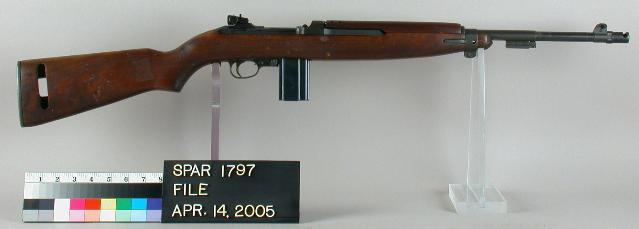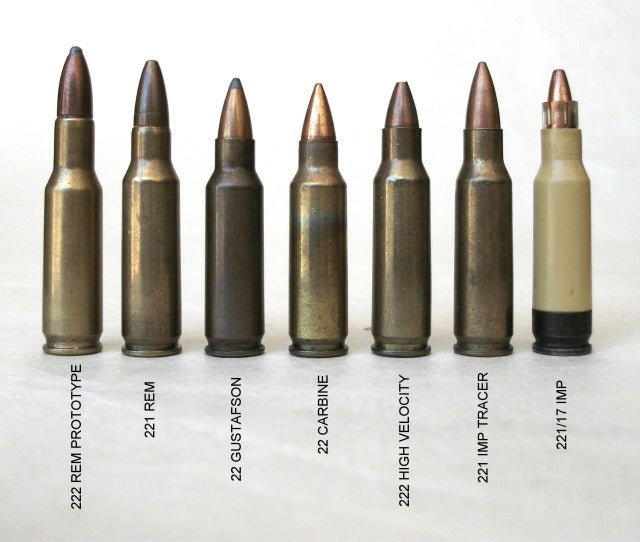Following the publication of the Hall report, but preceding it in conception, were two important documents in the origin story of the military .22 caliber cartridge. These were Operational Requirements for an Infantry Hand Weapon by Norman A. Hitchman, and Design and Fabricate a High-Velocity Caliber .22 Cartridge, Modify a Standard M2 Carbine to Fire the Cartridge, and Evaluate the Weapon-Ammunition Combination by G. A. Gustafson. Hitchman’s report, which is covered by site founder Steve in this 2011 article, is the herald of the end of the age of traditional marksmanship theory. In it, Hitchman evaluates infantry engagements in Korea and, to a more limited extent, World War II, to gain an idea of how the reality of rifle marksmanship in the mid-20th century stacked up against the theory. From the abstract:
Of what should a rifle be capable in battle today? Since there is a alimit as to how accurately the infantryman fires, can one increase hits by giving him a rifle with new operational characteristics? ORO’s Project BALANCE studied this by taking data on how often, and by how much, riflemen missed targets (as well as the distribution of hits) at different ranges, by taking data on the ranges of engagement in battle, and by taking data on the physiological wound effects of shots with differing ballistic characteristics. The recommendation is made that Ordnance proceed to determine the technological feasibility of a weapon with operating characteristics analyzed in this memorandum.
And from the Summary:
CONCLUSIONS
1. The ranges at which the rifle is used most frequently in battle and the ranges within which the greater fraction of man targets can be seen on the battlefield do not exceed 300 yd
2. Within these important battle ranges, the marksmanship of even expert riflemen is satisfactory in meeting actual battle requirements only up to 100 yd; beyond 100 yd, marksmanship declines sharply, reaching low order at 300 yd.
3. To improve hit effectiveness at the ranges not covered satisfactorily in this sense by men using the M-1 (100 to 300 yd), the adoption of a pattern-dispersion principle in the hand weapon could partly compensate for human aiming errors and thereby significantly increase the hits at ranges up to 300 yd.
4. Current models of fully automatic hand weapons afford neither these desirable characteristics nor adequate alternatives. Such weapons are valueless from the standpoint of increasing the number of targets hit when aiming on separated man-size targets.
5. Certain of the costly high standards of accuracy observed in the manufacture of current rifles and ammunition can be relaxed without significant losses in over-all hit effectiveness.
6. To meet the actual operational requirements of a general purpose infantry hand weapon, many possibilities are open for designs which will give desirable dispersion patters (and accompanying increases in hit probability) at the ranges of interest. Of the possible salvo or volley automatic designs, the small caliber lightweight weaon with controlled dispersion characteristics appears to be a promising approach. (Low recoil of a small caliber weapon facilitates dispersion control.)
7. To create militarily acceptable wound damage at common battle ranges, missiles of smaller caliber than the present standard .30 cal can be used without loss in wounding effects and with substantial logistical and over-all military gains.
8. A very great increase in hit lethality can be effected by the addition of toxic agents in bullet missiles.
Around the same time, and for the same reasons, the chief of the Aberdeen Proving Grounds’ Small Arms and Aircraft Weapons Section, Mr. Gerald A. Gustafson, published a study of his experiments converting an M2 Carbine to a shortened version of the then-new .222 Remington commercial rifle cartridge.

Gustafson’s modified M2 Carbine, for the .22 Gustafson/Aberdeen Proving Grounds cartridge. Note the characteristic muzzle brake. Image credit: Springfield Armory Museum.
Gustafson possibly experimented with the M2 Carbine because the standard .30 caliber infantry rifle – the M1 – had become something of a sacred cow within the Army, in part due to the great advantage its users enjoyed over those armed with manually-operated repeating rifles. The M2 Carbine, which had just acquitted itself rather poorly in the recent Korean conflict, was thus a fairly safe bet for near-heretical experimentation.

A selection of US .22 caliber experimentals. The .22 Gustafson is third from the left. Image credit: RayMeketa, IAA Forum.
Even the relatively tame .22 Gustafson cartridge – firing a lightweight 41 grain bullet at 3,000 ft/s – was determined by Gustafson to present acceptable ballistics and lethality out to 400 yards, even firing on the M1 Garand qualification course of fire (it was chosen, as the Carbine course was deemed “too easy” for the high velocity modified Carbines). In fact, the .22 caliber Carbine proved superior in the course of fire to the M1 Garand, out to 300 meters. Gustafson’s final recommendation was that .45 caliber submachine guns and .30 caliber carbines could be replaced with such a high velocity weapon – which they eventually were.
 Your Privacy Choices
Your Privacy Choices